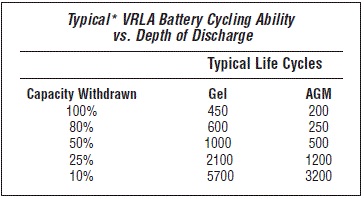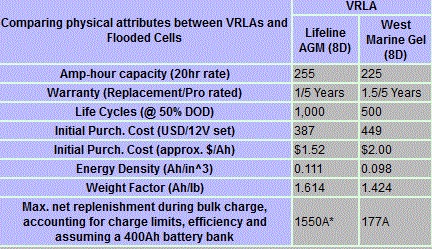Be sure to visit our storage homepage for more information.
I was doing a research for my customer. I ended up reading the Battery Life and Performance Factors on Greentech Renewables.
Here you mention that Gel batteries are more advantageous in terms of life cycle. I understand that the author has referred to MK/DEKA Battery technical document from where I take the below snapshot.
However, I was reading another article on this link (2nd snapshot added below) which mentions exactly the opposite: The AGM battery life cycle is higher than that of Gel batteries.
The question is; which one is correct?


Submitted
14 years 4 months ago
Topics
Comments
DEKA GEL battery cycle 1,000 times at a 50% depth of discharge at 77 degrees F, their batteries cycles 500 at 100% DOD.
Comparing cycle life charts of various manufacturers is not easy to do because each manufactures tests their batteries using different testing parameters to obtain the best results for their product. Most manufacturers do not publish their testing procedures.
DEKA results are based on The BCI (Battery Council International) 2 hour Capacity Discharge Test @77 degrees F. This means their batteries were discharged at their 2 hour rate to 1.75 volts per cell (10.5volts for a 12volt battery, a 100% DOD). The battery is then fully charged and is then discharged again. This is repeated until the battery no longer meets 50% of its 2 hour capacity (when it no longer runs for one hour). This is a very demanding capacity/discharge regime.
There are several ways to obtain better results from the test. If you discharge at a 20 hour rate rather than a 2 hour rate, the battery runs more efficiently. If you change the temperature, or the cutoff voltage or many other factors, you can achieve better results.
DELA tests their batteries under a very demanding regime and publishes under what parameters they use for testing. Many other battery manufactures don't state their parameters.
You should push all battery suppliers to share their testing procedures so that you are sure to compare apples to apples and batteries to batteries.
Thank you for the question Jose - we confirmed that the information provided in the article on our web site was correct.
Good article. I want to take advantage of this post to make a query to the expert, in case he could solve it for me.
For the charge and discharge cycles you mention, could a battery regenerator (charger and discharger kit) be worth it? I have seen that Amperis have a battery discharger and charger all in one pack in order to carry out these cycles and prolong the useful life of the batteries. The Amperis battery discharger is an automatic battery analyser and discharger designed to test the efficiency of industrial batteries of any type, voltage and capacity, and it can be programmed to discharge the battery at a precisely controlled constant current, adjustable from zero to the maximum value of the model while keeping the battery voltage under control. What do you think? Thank you!
Thank you for your comment. "Gel" and "AGM" refer to the structure of the battery electrolyte, not necessarily the chemistry although they are both typically a lead acid type. You can have AGMs and Gels that have competing and overlapping discharge and cycling profiles.
Think of it like this:
So, maybe if you have a wet battery or a battery that does not get a lot of use, you could try a battery maintainer, but really, it is probably better to put that money into a higher quality power conversion system (PCS) that can have custom settings to provide exactly that daily and maintenance charge/dischage that your battery chemistry needs.
Reply from Stuart Fox, Engineering Lead at Greentech Renewables.